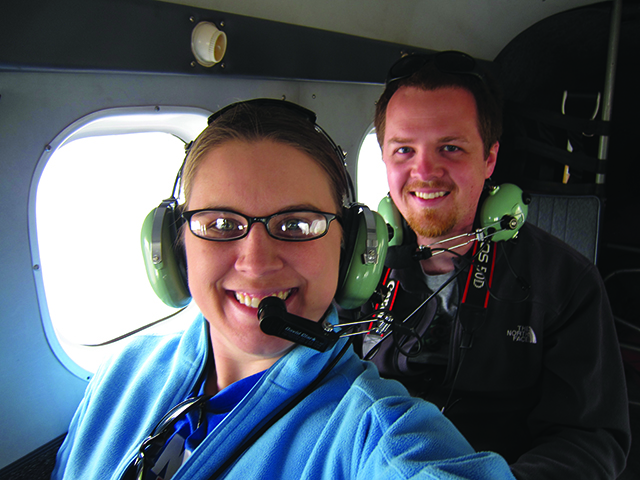Warm care in a frigid land
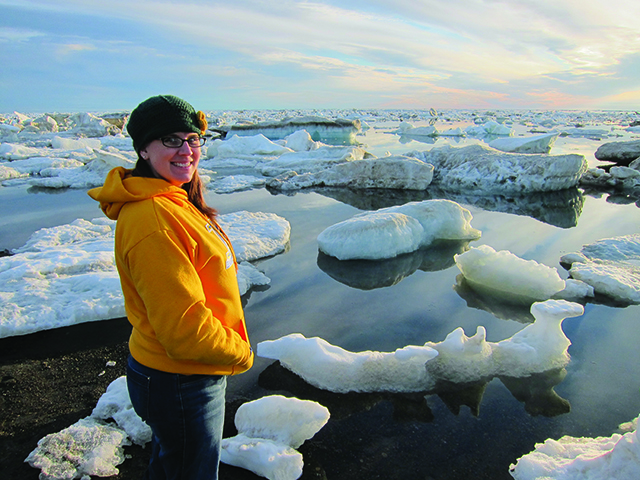
Months of constant darkness. Months of continuous light. High temperatures that don’t even reach freezing eight months of the year. Low temperatures 50 degrees below zero. Snow from October through June. Some would call this environment forbidding. Dr. Kim Self ’09 and her husband, Dr. Jonathan Oudin ’11, call this desolate spot home.
These Texas A&M University Baylor College of Dentistry alumni are in their third year as public health dentists with the Indian Health Service in Barrow, Alaska, the northernmost city in the United States. This outpost on the frozen tundra clings to the edge of the Arctic Ocean.
“I had always been interested in working in a more rural setting, and everywhere there’s an Indian Health Service clinic, it’s rural,” says Self. “Here in Alaska it’s ‘off the grid.’
“There are no roads leading into most of the towns in Alaska; you have to get there by plane or boat,” she says. “I thought it sounded like an amazing experience and adventure.”
A spark
Self traveled to Barrow for a two-week “externship” before her final year of dental school to get a hands-on feel for life and employment there. Whereas some would avoid winter in northern Alaska like the plague, she elected to return in December that same year.
When Oudin was a predental student at Texas A&M University, he came home one weekend and told his parents about a public health dentistry presentation he had heard. It involved working in Alaska. And he was intrigued. By the time he and Self were both dental students, the idea evolved into a reality.
“She waited until we were married and I graduated, and then we moved up here. She had to convince me, but it didn’t take too much,” Oudin explains.
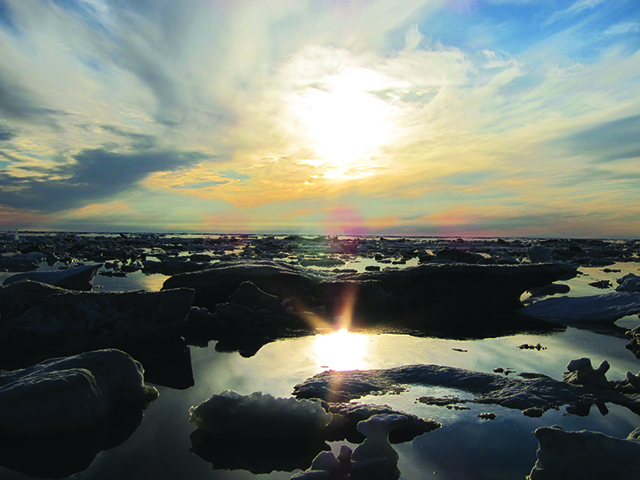 Self is not the least surprised the two are now living their dream together. “I believe God has things work for a reason,” she says.
Self is not the least surprised the two are now living their dream together. “I believe God has things work for a reason,” she says.
The roots of Self’s sense of adventure stretch back to a sleepy hometown: Malta, Texas, population 297 at the time she entered elementary school. In this tiny northeast Texas community, public school goes through sixth grade, and chicken farmers spend weekdays hard at work and Sunday mornings at church. Self’s father worked for the government in a position that required travel around the country. When school wasn’t in session, the rest of the Self family went with him.
“My first road trip was at 7 months old. My mom was a teacher so she had the summers off,” explains Self. “We’d just pack up and go see everything along the way. I’ve been to almost all of the 50 states; most before I graduated high school. Adventure has always been in my blood.”
Land of extremes
Reaching the top of the world is an experience that requires willpower and resources. Case in point: the journey from Dallas to Barrow. This trek requires 28 hours round-trip and a cool $1,300. Driving is not an option because there are no roads in and out of Barrow. Travelers must arrive by plane, enduring at least three airport layovers. And every prepared sojourner packs ample cold-weather gear.
“I love the winter; it’s my favorite time,” Self says. “The snow covers all the dirt so it looks a lot prettier. Here the climate is so different. Having to do all the varied things to get ready to go outside is an adventure.”
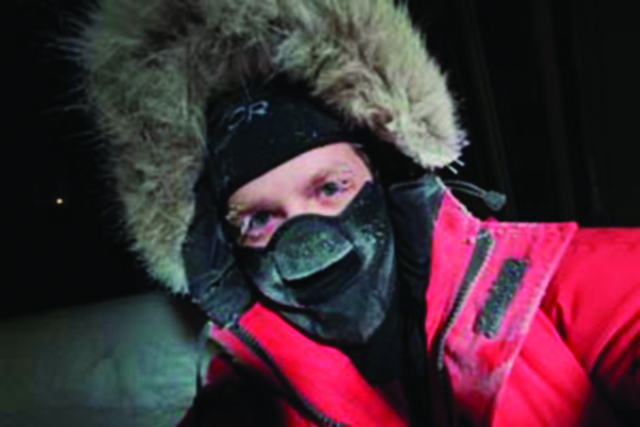 For reference, this adventure of dressing for subzero temperatures is a story of layers. Starting with the legs, the prepared Alaskan pulls on long underwear and then covers it with jeans and snow pants. For the feet, expedition-weight wool socks get topped with Muck arctic sport boots rated to -40 degrees Fahrenheit. Moving to the upper torso, the outfitting begins with long underwear, then flannel shirt, topped with a fleece jacket and ultimately a down parka. Layers continue with gloves for the hands, scarf around the neck, and a balaclava, or face mask, if needed.
For reference, this adventure of dressing for subzero temperatures is a story of layers. Starting with the legs, the prepared Alaskan pulls on long underwear and then covers it with jeans and snow pants. For the feet, expedition-weight wool socks get topped with Muck arctic sport boots rated to -40 degrees Fahrenheit. Moving to the upper torso, the outfitting begins with long underwear, then flannel shirt, topped with a fleece jacket and ultimately a down parka. Layers continue with gloves for the hands, scarf around the neck, and a balaclava, or face mask, if needed.
Oudin is as pragmatic about the cold as his wife.
“The cold is a gradual shift from the summer so it doesn’t require that much adjustment,” he says. “You buy the right gear for the weather. Our signing bonuses were spent on clothes.”
Self and Oudin live in a three-bedroom house with one bath provided as part of their employment agreement. Aside from adjusting to extensive travel and a changing schedule, Oudin mentions a unique challenge of winter in the far north.
“Our pipes freeze so we have to be flexible about where we live. If no one flushes our toilets every day the house freezes up. Then you need the company with heat pumps to thaw everything out. Heat pumps have a wait list of two to three weeks. Sometimes they’ll put us up in a hotel, or they might give us a five-gallon ‘honey bucket’ with a toilet seat on it.”
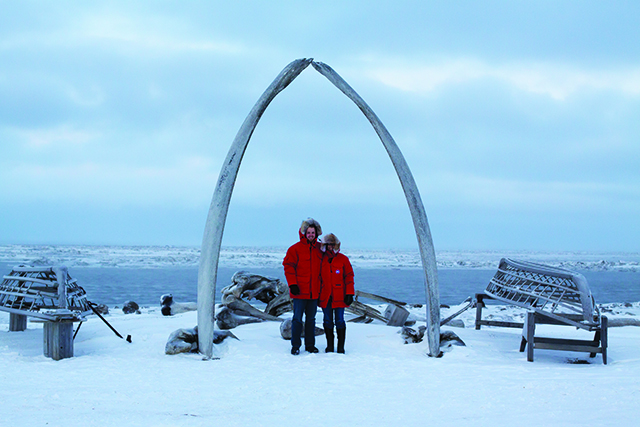
Lodging in the outlying villages takes the shape of a two-bedroom apartment attached to each village’s health clinic. This is convenient when available, but demand sometimes exceeds supply.
“If all the rooms are filled, we stay in clinic offices, school classrooms or fire department bunk houses,” Oudin says.
Returning to Texas for a visit requires adapting to the flip side of extreme climate and lifestyle differences, specifically heat and bustling humanity.
After living with polar bears, face masks, sea ice and unpaved streets that turn to mud during snowmelt, “Getting back to a city is stressful,” Oudin says. “I’m not used to traffic anymore.”
The wilderness
The remoteness of northern Alaska is precisely the reason that Oudin’s and Self’s work is so needed. North Slope Borough is a vast, sparsely populated region – larger than the state of Utah – consisting of Barrow and seven far-flung villages, five of which receive visits from Oudin, Self and the deputy dental director at Samuel Simmonds Memorial Hospital in Barrow.
“Our villages have a population between 250 and 500 people,” Oudin explains. “I go to Atqasuk and Nuiqsut, and Kim Goes to Kaktovik and Point Lay. We each spend seven weeks in the villages a year; three times to one village and four times to the other.”
Era Alaska airplanes, featured on the Discovery Channel’s show “Flying Wild Alaska,” provide the dentists’ air transportation, either via single-engine propeller planes that seat six passengers or dual-engine planes that seat 19. Takeoffs and landings occur not on concrete but on gravel or ice runways. Traveling to the farthest village, Kaktovik, takes three flights and three hours to go 310 miles.
 A scheduled trip is at the mercy of the Alaskan weather, so travel is unpredictable. Icing conditions on aircraft are common; it’s the storms that bring low cloud ceilings and reduce visibility to near zero that make flying hazardous. It’s not unusual for six-day trips to a village to extend to 10 days.
A scheduled trip is at the mercy of the Alaskan weather, so travel is unpredictable. Icing conditions on aircraft are common; it’s the storms that bring low cloud ceilings and reduce visibility to near zero that make flying hazardous. It’s not unusual for six-day trips to a village to extend to 10 days.
“I’ve had a few interesting experiences on the small planes,” Self says. “The altimeter went out on one recently. That made for an interesting landing. The pilot was hanging his head out the window to see the runway. Most of the time it’s standard stuff.”
Her exposure to Alaskan travel adventures began the moment she landed in the state in August 2008. After being told she wouldn’t be going to a village during her externship, Self was sent – by herself – for a village health fair in Kaktovik on her first official day. Travel to a village requires taking a week of food.
“They told me, ‘You need to grab food and pack that. I don’t know where you’ll sleep, but here’s a sleeping bag,’” Self explains. “A sleeve of Ritz crackers and a jar of peanut butter was all I had with me, and I figured I’d just make it work.
“I was really blessed because right when I got there I met the fire station chief. To this day he’s my best friend in this village.
He took me to his house and fed me. His sister lived with him at the time, and she would cook. It was nice to be a part of something.”
The impact
The remote location and an extraordinarily high level of soda consumption impact the severity of dental problems. Severe toothaches are common, says Oudin, due to a combination of sugary diet, poor oral hygiene and no fluoridated water.
“In the Alaska Native population the decay rate is through the roof,” says Dr. Kimlea Medlin, dental director at the Indian Health Service clinic and a Barrow dentist since 2006. “The national decay rate is 25 to 30 percent. Among Alaska Natives and the American Indian population, the decay rate is above 75 percent. In North Slope local numbers, the decay rate in children in some villages is 100 percent, which means every child has active cavities or treated decay.”
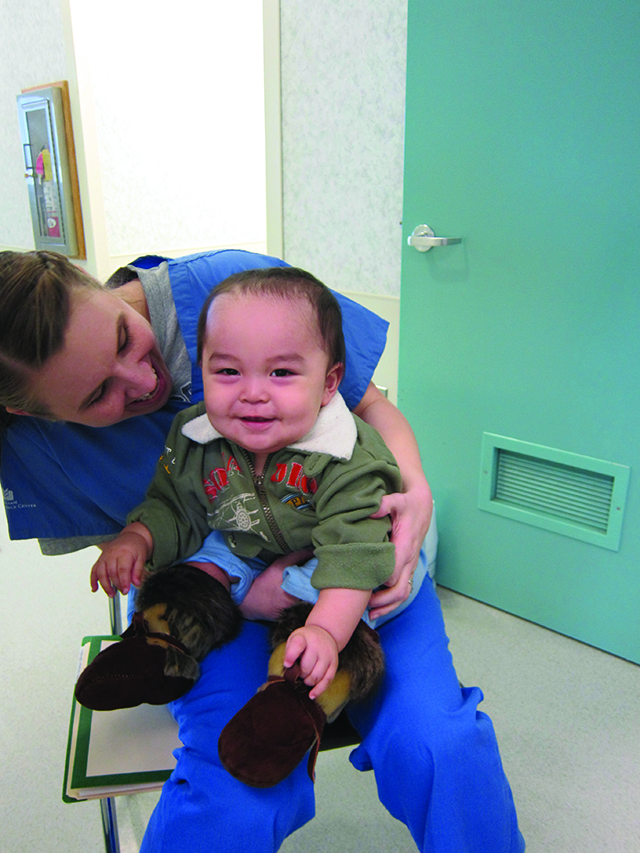
Soda consumption numbers point to a source of the problem. According to the manager of Barrow’s largest local grocery store, AC, soda sales average 5,000 cans per resident annually, despite the fact that a 12-pack costs $13.
“It’s not uncommon for a person to drink one or two 12-packs per day,” says Oudin. “Ninety percent of kids go to Anchorage to get full-mouth rehabilitation.”
Self adds, “I don’t feel it’s due to a lack of education; it’s a cultural norm: ‘It’s OK not to have teeth; Mom doesn’t have them, Grandma doesn’t, brother doesn’t; I don’t need them.’ It’s better than it used to be but still has a long way to go.”
Large families consisting of children that are not all from the same parents and the offspring of teen pregnancy add a layer of difficulty in providing dental care to the native Inupiat population. It is common for other family members such as aunts, uncles or grandparents to adopt children who exceed what a family can adequately support.
“It’s a very different culture here,” Self says. “It’s difficult to figure out whom to get consent from for a 3-year-old who needs care because ‘Mom’ may not be the mom who’s the legal guardian. It’s a challenge.”
Sometimes in the Alaskan tundra, Self and Oudin are asked to step outside their dental sphere and render medical aid for lacerations to hands, limbs or faces.
“When we’re out in the villages we are the highest level providers, so they often call on us to do sutures and so forth,” Oudin says. “We see a lot of injuries, including broken jaws from aggressive snow machine and four-wheeler use.”
Self points to the child who has improved his oral health habits as an indication the dentists’ Alaska work is making a difference, but she is introspective about her personal experiences.
“I thought I was very adaptable to any culture with no problems,” says Self. “But no matter how much you are able to adapt, you are still going to have challenges to work through without quitting or giving up.
“One reason community members are leery of outsiders is because they think they are there for a fleeting moment and gone. Our staying around a third year will help show people there are professionals who want to serve their native Alaskan community.”
Northern Exposure: Externship previews life in Alaska
The Indian Health Service dental externship in Barrow, Alaska, is an indispensable tool for exposing potential public health dentists to the North Slope. Between 10 and 14 students spend two weeks in the Barrow area, usually including a remote village trip, in the summer before their fourth year of dental school. Externs are accepted through a competitive application process and receive travel, housing and food for the duration.
Dr. Kim Self completed the externship in 2008. Some family and friends who heard details about her Alaska experience asked,“Are you sure you really want to do this?” She was undeterred.
“During my externship I learned that you have to be extremely flexible and willing to roll with whatever obstacle is put in front of you,” says Self. “I had to learn how to adapt to Alaska culture; it was not what I was expecting.”
Self and husband, Dr. Jonathan Oudin, are in their third year as public health dentists at Samuel Simmonds Memorial Hospital, site of Barrow’s community dental clinic. The hospital cut the ribbon on a new facility this fall that includes a dental clinic with 10 chairs instead of six, all-new equipment and more “elbow room.” Two additional dentists – the director and the deputy director – and a dental hygienist, who is the first at the clinic since 2006, complete the dental staff.
The transplanted Texans impress their colleagues and patients. “Kim and Jonathan have been a huge blessing to the clinic and a lot of fun to work with,” says Dr. Kimlea Medlin, dental director. “They are kind, professional, polite, incredibly conscientious with patients and staff and very much liked and appreciated by the communities they serve.
“The externship is incredibly important for recruiting across the board for Indian Health Service dental clinics. We’ve offered contracts to only two dentists out of 10 over the past seven years who didn’t come through the externship program. One of those was Dr. Oudin, who happens to be married to Dr. Self.”
Information about the IHS externship is available at www.ihs.gov. Email Oudin or Self with questions at jonathanoudin@gmail.com.
“Externs should be ready for a remote, cold place with limited Internet and spotty cell phone coverage,” advises Oudin.
The adventurer’s life
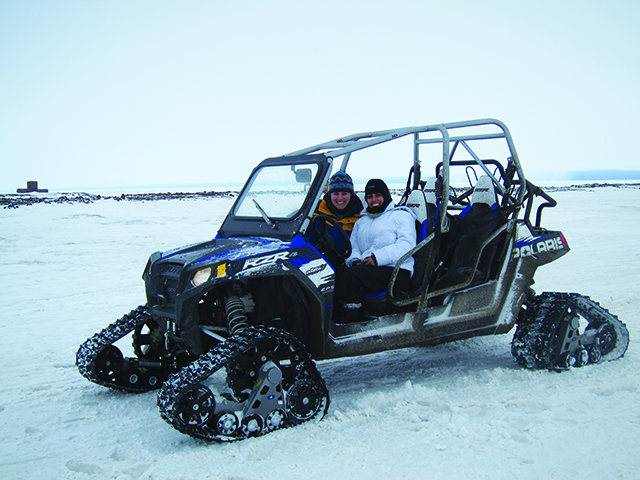
Exploring Alaska’s scenery and culture is a perk of Oudin’s and Self’s location.
Time off is spent in “big city” Anchorage, population 291,000, and in Fairbanks, the state’s second-largest city. Long summer days away from Barrow are spent whale watching, fishing for Pacific Halibut along the Kenai Peninsula in Seward and Homer or hiking and kayaking down glacier-fed rivers. The Alaska Railroad has taken the dentists gliding past magnificent snowcapped peaks, nesting eagles, brown bear and moose.
“Traveling around Alaska has been fun,” Oudin says.
“We really love Seward,” concurs Self. “It’s a small fishing village where the mountains come straight up out of the water just like a postcard. We don’t live in postcard Alaska. We just live in flat tundra.”
In early August, the two ventured 414 miles north from Fairbanks along the largely primitive James Dalton Highway – the only Arctic-access highway – past oil pipeline outposts like Coldfoot and Deadhorse to Prudhoe Bay. Their mission was both scenic and practical: retrieving a Jeep they purchased in Fairbanks. After reaching Prudhoe Bay, the couple put their new vehicle on a barge to Barrow for $4,000. It reached them the next week.
“We had bought a vehicle from the dentist we replaced up here, but unfortunately it caught fire and burned down in March,” Oudin says. “Since then we have been borrowing a vehicle when needed.”
The Dalton Highway opened for public use about 20 years ago and beckons summer travelers with incomparable mountain, valley and wildlife vistas. Dubbed the “haul road” because trucks use it to supply the oil fields in the north, large portions remain gravel when they are not covered in ice during the winter. This is when the road becomes the focus of the “Ice Road Truckers” show on the History Channel.
Close to home, the two fish for salmon, anchoring a net 100 feet offshore each August in the Beaufort Sea, located just 3 miles north of Barrow. The net stays in place for a month and a half and is simply hauled in from the shore.
“I caught all Alaskan salmon species in my net last summer except for Coho, including Pink, Chum, Sockeye and King,” Oudin says. “This summer my net was less successful. We think the salmon ran early before the ice left and before we got our net out.”
The couple’s next big adventure? Baby Elijah, due in April.
This story originally appeared in the Spring 2014 Baylor Dental Journal, a biannual alumni publication of Texas A&M University Baylor College of Dentistry.
